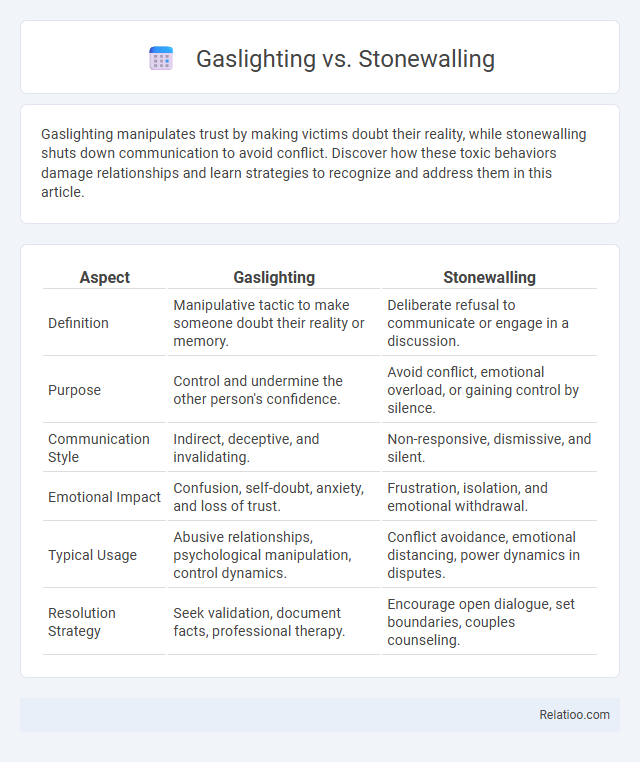Gaslighting manipulates trust by making victims doubt their reality, while stonewalling shuts down communication to avoid conflict. Discover how these toxic behaviors damage relationships and learn strategies to recognize and address them in this article.
Table of Comparison
| Aspect | Gaslighting | Stonewalling |
|---|---|---|
| Definition | Manipulative tactic to make someone doubt their reality or memory. | Deliberate refusal to communicate or engage in a discussion. |
| Purpose | Control and undermine the other person's confidence. | Avoid conflict, emotional overload, or gaining control by silence. |
| Communication Style | Indirect, deceptive, and invalidating. | Non-responsive, dismissive, and silent. |
| Emotional Impact | Confusion, self-doubt, anxiety, and loss of trust. | Frustration, isolation, and emotional withdrawal. |
| Typical Usage | Abusive relationships, psychological manipulation, control dynamics. | Conflict avoidance, emotional distancing, power dynamics in disputes. |
| Resolution Strategy | Seek validation, document facts, professional therapy. | Encourage open dialogue, set boundaries, couples counseling. |
Understanding Gaslighting: Definition and Examples
Gaslighting is a psychological manipulation tactic where the abuser makes the victim doubt their own memories, perceptions, or sanity, often through persistent denial, misinformation, and contradiction. Examples include insisting that events never happened, dismissing the victim's feelings as irrational, or twisting facts to confuse and control. Unlike stonewalling, which involves shutting down communication to avoid conflict, gaslighting actively undermines the victim's reality to gain power and control in relationships.
What is Stonewalling? Key Characteristics
Stonewalling is a communication barrier where one person withdraws, shutting down emotionally and refusing to engage in a conversation. Key characteristics include silence, avoidance, and unresponsiveness, often leaving your partner feeling ignored and frustrated. Unlike gaslighting, which manipulates reality, stonewalling creates emotional distance by refusing to interact or address issues.
Psychological Impact of Gaslighting
Gaslighting manipulates your perception of reality, causing self-doubt, confusion, and emotional instability, which severely impacts mental health by fostering anxiety and depression. Stonewalling, characterized by emotional withdrawal and refusal to communicate, intensifies feelings of isolation and frustration but lacks the direct distortion of facts found in gaslighting. The psychological impact of gaslighting is more insidious, systematically undermining your confidence and sense of reality, making it harder to trust your own judgment over time.
Emotional Consequences of Stonewalling
Stonewalling in relationships often leads to emotional distress, including feelings of abandonment, frustration, and helplessness, as the silent treatment blocks communication and resolution. Unlike gaslighting, which manipulates perception and self-trust, stonewalling creates emotional distance that fosters isolation and decreases emotional safety. The chronic emotional consequences of stonewalling include increased anxiety, resentment, and potential long-term damage to self-esteem and trust within interpersonal connections.
Gaslighting vs Stonewalling: Core Differences
Gaslighting involves manipulating someone into doubting their reality, memory, or perceptions, often causing confusion and self-doubt, whereas stonewalling is characterized by emotional withdrawal and refusal to communicate or engage during conflicts. Gaslighting actively distorts truth to control, while stonewalling passively avoids conflict, creating emotional distance. Understanding these core differences is crucial for identifying toxic relational patterns and implementing effective communication strategies.
Common Signs of Gaslighting in Relationships
Common signs of gaslighting in relationships include persistent lying, denying facts despite clear evidence, and manipulating your perception of reality to create self-doubt. Victims often feel confused, second-guess themselves, and struggle to trust their own memory or judgment. Recognizing these patterns helps differentiate gaslighting from stonewalling, which typically involves emotional withdrawal and refusal to communicate rather than active distortion of truth.
Recognizing Stonewalling Behavior
Stonewalling behavior involves refusing to communicate or engage, often leaving You feeling ignored and frustrated during conflicts. Unlike gaslighting, which manipulates Your perception of reality, stonewalling manifests through silent treatment or emotional withdrawal. Recognizing stonewalling is crucial to addressing communication breakdowns and fostering healthier relationship dynamics.
Why People Gaslight or Stonewall: Underlying Motives
People gaslight to manipulate others by distorting reality, often driven by a need for control, power, or to avoid accountability in relationships. Stonewalling occurs when individuals withdraw or shut down communication to evade conflict, protect themselves emotionally, or maintain dominance by withholding interaction. Both behaviors reflect underlying motives related to fear, insecurity, and a desire to manage how others perceive or respond to them.
Protecting Yourself from Manipulative Tactics
Recognize gaslighting as a psychological manipulation tactic that distorts your perception of reality, while stonewalling involves emotional withdrawal to avoid communication. Protecting yourself requires setting firm boundaries, maintaining clear, documented communication, and seeking support from trusted individuals or professionals. Developing emotional awareness and strengthening self-confidence are crucial defenses against these manipulative tactics.
Healing After Gaslighting or Stonewalling
Healing after gaslighting or stonewalling requires recognizing and validating your emotions to rebuild self-trust and confidence. Focusing on therapy techniques such as cognitive behavioral therapy (CBT) and trauma-informed counseling can effectively address the psychological impact of these manipulative behaviors. Establishing boundaries and seeking support from trusted friends or support groups enhances the recovery process by promoting emotional resilience and empowerment.

Infographic: Gaslighting vs Stonewalling
 relatioo.com
relatioo.com